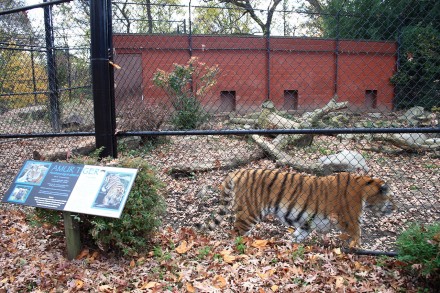
News release from Connecticut’s Beardsley Zoo:
Connecticut’s Beardsley Zoo’s ten-year-old Amur tiger (Panthera tigris altaica), Changbai, gave birth on November 25 to four tiger cubs, although only two survived. The two surviving cubs, both females, were removed from Changbai when she showed no interest in taking care of them. Both two-week-old cubs are in seclusion in the Zoo hospital, housed in a 90-degree ambient temperature enclosure, with a base warmed to 85 degrees to sustain the cubs’ warmth.
“We are hand feeding the babies five times a day,” explained Zoo Director Gregg Dancho. “They are being given a feline milk replacement formula, supplemented with vitamins. They are a little underweight, possibly due to the age of their mother and the fact that there were four kittens in the litter.” Survival of the two remaining cubs is still a challenge. Zoo veterinarians and animal care staff are doing everything they can to get them through this critical time. It will be several more weeks before the cubs will be available for viewing by the public.
Zoo staff was aware of the tiger’s pregnancy through fecal hormone testing, and had been keeping a 24-hour watch on Changbai for the past few weeks. A female tiger at the age of ten has only a twenty percent change of a successful pregnancy, so good husbandry and a quick response from the animal care team makes a difference. When Zoo staff saw the firstborn kitten unresponsive and that Changbai was disinterested in grooming or nursing the remaining kittens, a decision was made to remove them to begin feeding. A second kitten died later that night.
Zoo veterinarians and animal care staff are providing around the clock care and supervision for the remaining cubs. The two kittens’ survival is an important step forward in maintaining the genetic diversity of Amur tigers worldwide, a critically endangered species that is rapidly disappearing from the wild. The kittens’ survival to two weeks was a critical milestone, but it will be another few weeks before they can be considered out of danger.
Dancho said that every possible effort was being made to help the kittens survive. “The birth of these kittens brings a few more precious tigers to the population, which can help ensure the survival of these majestic animals for future generations.”
Amur tigers, also known as Siberian tigers, are very rare. According to the Association of Zoos and Aquariums’ (AZA) statistics, today’s tigers are thought to occupy less than seven percent of their original range. Threatened by habitat loss and degradation, poaching, tiger-human conflict, and loss of prey, four of nine subspecies have disappeared from the wild just in the past hundred years. The future of the Amur tiger has been a major concern of the world’s zoos for many years.
All tigers now have protected status in the wild, but that doesn’t guarantee their safety. A breeding program recommendation comes from the Species Survival Plan (SSP), administered by the Association of Zoos and Aquariums in accredited zoos. Connecticut’s Beardsley Zoo is home to the parents, a male, Petya, and a female, Changbai, who joined the Zoo family last winter. Managed by the SSP, inter-regional transfers are arranged with careful attention to gene diversity in the hope that successful breeding will take place. Chang was sent to Connecticut’s Beardsley Zoo as an excellent genetic match to the Zoo’s resident male tiger.
Connecticut’s Beardsley Zoo will provide update on the kittens’ condition on its website and on Facebook.
About Amur tigers
The Amur, or Siberian tiger, is a rare subspecies of tiger, and the largest cat in the world. Adult male tigers can weigh up to 675 pounds, with females weighing up to 350 pounds. Chang is small for a female Amur tiger, weighing 297 pounds. Similar to people’s fingerprints, no two tigers have the same striped pattern. Amur tigers differ from other tigers with fewer, paler stripes, and a mane that helps to keep them warm. They live in southeast Russia as well as small areas of China and North Korea. They live for 10-15 years in the wild, and up to 22 years in captivity.


How generous of Zoo Director Gregg Dancho. I called him to get the story on the Tigers. I started the phone interview with the first question:
Q: Mr. Dancho, how are the tigers doing?
A: They’re GRRRRREAT for 2018 Connecticut’s Beardsley Zoo Promotions.
When I started asking the second question, all I could hear was the disconnect sound.
A heart-warmimg posting from OIB. Thank You!